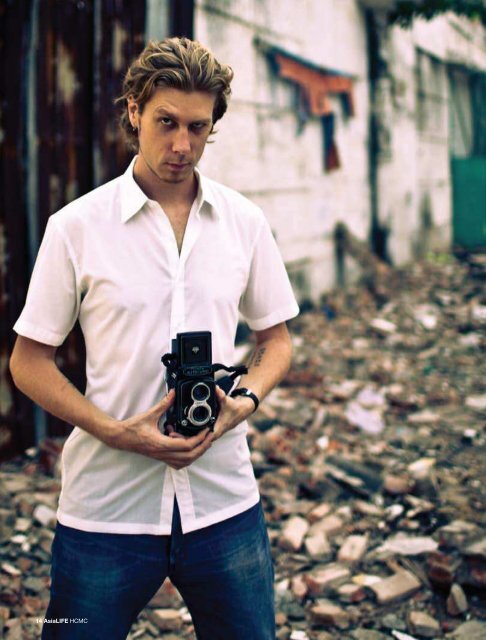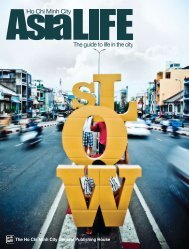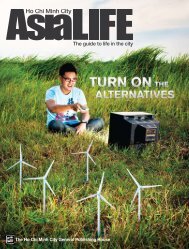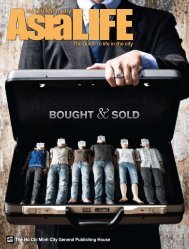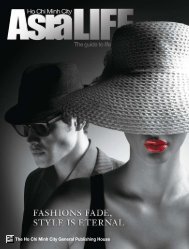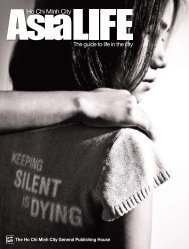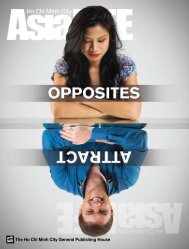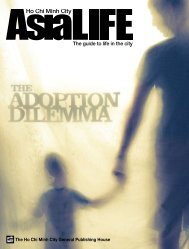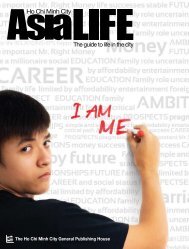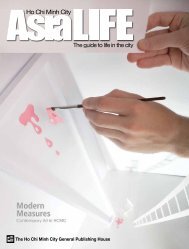transition - AsiaLIFE Magazine
transition - AsiaLIFE Magazine
transition - AsiaLIFE Magazine
- No tags were found...
Create successful ePaper yourself
Turn your PDF publications into a flip-book with our unique Google optimized e-Paper software.
From prison guard in training to our very own photographer, Fred Wissink’smove to Asia signalled a complete career change. Photo by Christian Berg.We heard you were a prisonguard back in Canada…[Laughs]. Well, sort of. In 1996I graduated high school andwanted to be a graphic artist. Iapplied, but my portfolio wasn’tstrong enough. So I applied for alaw and security administrationcourse at a vocational college. Igot in and really enjoyed it.After I finished the diploma,I figured I’d do a year or twoworking for the correctionalservice. I applied and got in—they’ll pretty much take anyone.Oddly, it was one of the bestexperiences I ever had. We didtwo weeks training in a mediumsecurity prison. I came acrossso many interesting characterswhile I was there—a mafia hitman and a guy who’d beenin jail since 1968. He’d beenextradited from the States on amurder charge. I didn’t finishthe course though. My trainersthought I had potential to bea great guard, but they said Iwasn’t mature enough yet, sothey canned me. Six monthslater I was in Korea.Why did you decide to go toKorea?I was looking for a job and sawan ad the size of my pinkiefinger in the newspaper thatsaid “Teach English in Korea”. Ithought it sounded like fun, soI got my TESOL certificate andwithin a month I was there. Ilanded in September 1999 andstayed until Spring 2002. Then Iwent to China, worked there fora few months before heading toTurkey and back to Korea. I leftin 2006 and came to Vietnam.What were your impressionsof Korea?I loved it. It was my first timeout of Canada—my flight therewas my second time on an airplane.I had an interest in learningthe language and I met somereally good people there. Therewere so few expats there at thattime that you knew everyone. Itwas a lot of fun.You learned Korean, but youhaven’t really mastered Vietnamese.Why?I learned Korean and Chinese,but I didn’t learn Vietnamese.When I first came here, I wasplanning on going back toChina. I had no plan to stay hereso I wasn’t so inclined to learn.Also, Korean’s non-tonaland once the locals get over theshock of hearing a foreignerspeak their language they’rewilling to listen and try tounderstand. The Chinese expectyou to speak their language.Even though it’s a tonal language,there’s so many Chinesedialects that they need to thinkin context. It’s much harder inVietnam. But, I can speak a lotmore than I did when I firstcame here—survival plus a bitmore.How did your photographycareer begin?I bought my first camera in Koreain 2000. I promptly broughtit to a bar and it was stolen. Mynext one was a 1.3 mega pixelSony Cyber Shot I took from afriend to clear a debt. It had alittle postage stamp sized screenand I shot China with it. I shotall my pictures at the lowest resolutionbecause I had no extramemory cards and no cable toconnect to my computer. I lookback at those photos now andthey’re all so tiny. I can’t use anyof them. I kept upgrading, andeventually held an exhibition inPham Ngu Lao, which sold out.They were real amateur travelshots, but I’d started calling myselfa photographer. Then I metPaul Norris who owns L’Usineand he asked me to shoot theupcoming collection for hisclothing line Unavailable. I tookthe job, it turned out great andI’ve shot for them ever since.I started working for <strong>AsiaLIFE</strong>in Fall 2006, when it was stillcalled Saigon Inside Out. Themagazine has given me a chanceto grow and get a lot better. Peoplewho’ve known me for yearstell me that my work’s changeddramatically since I first startedworking for <strong>AsiaLIFE</strong>.Describe that progression. Howhas your work evolved?I think it’s a better eye for whatI’m looking for. It’s willingness,the confidence to try outnew ideas and concepts. NowI know what my strengths andweaknesses are. I used to be apurist and not want to re-touchanything. But I’ve learned thatthere are times when you haveto make your work funky anddifferent—you have to standout.Do you have a favourite shot?I liked the first <strong>AsiaLIFE</strong> doublepage spread. It had a femalemodel wearing earphones surroundedby coloured lights. Iactually thought of the concept.I shot the girl first, then we tookflashlights with coloured plasticon the ends and whipped themaround, shooting with a longexposure. We light painted likecrazy. Then the graphic designersput all the lights together.That’s one of my favouritepictures.I like some of the portraitsI’ve been doing, too. I do findmyself gravitating towardspeople now. I used to be reallyshy of taking pictures of people,but I’m more confident now.What’s next?I want to expand out of Vietnam.I don’t see a future forphotographers here. The futureis the Vietnamese. There maystill be a place for foreign photographers,but the Vietnameseare learning so fast we’re goingto become obsolete very soon.The next step for me is to gobeyond the borders of SoutheastAsia. I’d really like to spendsome time back home working,as well. Vietnam was an awesomeplace to learn but it’s timeto start thinking global.14 asialife HCMC asialife HCMC 15


